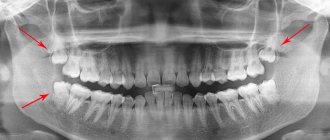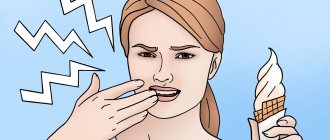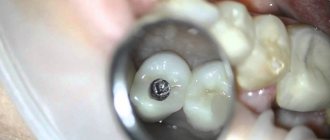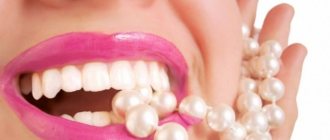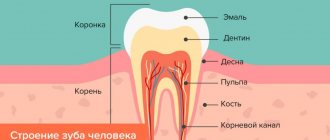Dentists recommend undergoing preventive examinations at least once a year and, if caries is detected, treating it at an early stage. Unfortunately, many patients go to the doctor with an advanced form of the disease. In this article we will tell you why and how deep caries occurs, and we will tell you about treatment methods.
In this article
- Areas affected by caries and stages of the disease
- Deep caries and its features
- Risk factors for deep caries
- Forms of deep caries
- Features of diagnosing deep caries
- How can deep caries be cured?
- Conclusion
Areas affected by caries and stages of the disease
Caries is a dental disease in which, under the influence of microorganisms and other factors, the structure of dental tissues is destroyed.
The mechanism of development of the disease is due to the vital activity of bacteria Streptococcus mutans and some other species. They have a cariogenic effect and create conditions for the development of the carious process. It goes like this. Bacteria accumulate on teeth and form a biological film called plaque. When we eat foods rich in carbohydrates, plaque bacteria actively process the sugars they contain and produce organic acids that are dangerous to our teeth. They destroy the enamel structure, deprive it of minerals, and penetrate deep into the tooth. The more acids produced by oral microorganisms, the more active and rapid the destruction of dental tissue.
Damage to teeth by caries does not occur instantly; it can take several months from a small spot to the appearance of a hole in the tooth. Based on how deeply the carious process penetrates, several stages of the disease are distinguished.
- The earliest is the spot stage.
A small focus of demineralization appears on the surface of the enamel. It looks like a whitish dot or streak. It is almost impossible to notice such changes with the naked eye. And provided that there are no other symptoms (pain or discomfort) at this stage, a person often misses the onset of caries and does not see a doctor.
- Superficial caries.
If the stain was not noticed in time, it gradually grows, the enamel tissue is destroyed, and a cavity is formed in it - a small hole. As a rule, there is still no pain, although food may get into the cavity or tooth sensitivity may increase.
- Average caries.
The form of average caries is characterized by the penetration of the pathological process into dentin - the bone tissue under the enamel. At this stage, a carious cavity forms in the dentin, pain becomes severe, and the tooth reacts to temperature or taste stimuli. Most often, people go to the dentist with the listed symptoms.
- Deep caries.
If for some reason you do not treat average caries, the pathology progresses and approaches the pulp - the dental nerve. This is the most complex and dangerous form of caries, because there is a high risk of infection spreading to the pulp, periodontium and the development of complications.
Modern concept of the etiology of caries
Based on historical theories , significant progress has now been made in studying the etiology and pathogenesis of dental caries.
The generally accepted mechanism for the occurrence of caries is the progressive demineralization of hard dental tissues under the influence of organic acids, the formation of which is associated with the activity of microorganisms.
Many etiological factors take part in the occurrence of the carious process, which allows us to consider caries a polyetiological disease.
The main etiological factors are:
· microflora of the oral cavity;
· nature and diet, fluoride content in water;
· quantity and quality of salivation;
general condition of the body;
· extreme effects on the body.
All of the above factors were called cariogenic and divided into general and local, which play an important role in the occurrence of caries.
General factors:
1. Poor diet and drinking water.
2. Somatic diseases, changes in the functional state of organs and systems during the period of formation and maturation of dental tissues.
3. Extreme effects on the body.
4. Heredity, which determines the usefulness of the structure and chemical composition of tooth tissue. Unfavorable genetic code.
Local factors:
1. Dental plaque and dental plaque, replete with microorganisms.
2. Violation of the composition and properties of oral fluid, which is an indicator of the condition of the body as a whole.
3. Carbohydrate sticky food residues in the mouth.
4. Resistance of dental tissues, due to the complete structure and chemical composition of the hard tissues of the tooth.
5. Deviations in the biochemical composition of hard dental tissues and defective structure of dental tissues.
6. Condition of the dental pulp.
7. The state of the dental system during the period of formation, development and eruption of teeth.
Cariogenic factors can be of varying intensity and nature, different options for their interaction contribute to the occurrence of caries, but the leading factor is the microflora of the oral cavity. It is now known that the carious process can develop in the presence of microorganisms in the oral cavity, excess amounts of carbohydrates in food and contact of carbohydrates and microorganisms with tooth enamel. It is well known that carbohydrate intake causes increased acid formation. Thus, taking 10 grams of sugar leads to an increase in lactic acid in saliva by 10-16 times [Leontyev V.K., 1978]. Studies have shown that at a pH more acidic than 6.2, saliva goes from being oversaturated with hydroxyapatite to undersaturated, and therefore turns from a mineralizing liquid to a demineralizing liquid (destroying the hard tissues of teeth). According to modern ideas, the cause of caries is prolonged exposure to acids on dental tissues. The formation of organic acids is associated with long-term enzymatic activity of microorganisms. Long-term exposure to organic acids on tissues is observed with poor oral hygiene, when a dental plaque forms on the enamel; it is under it that an acidic environment is created as a product of the enzymatic activity of a huge number of microorganisms that are capable of ideally absorbing carbohydrates retained in the oral cavity.
Thus, a carious cavity is formed in places of intense acid production, under the dental plaque, where the pH is more acidic 4 - 5. With good washing of the teeth with oral fluid, rare intake of sugar, the local pH shift is quickly leveled out. However, in areas of poor saliva access, with frequent intake of sugar, the demineralization process may prevail over the remineralization process. This means that carbohydrate consumption can be a decisive factor in the shift in pH and disruption of mineralization processes, which leads to the occurrence of caries.
It should be noted that the action of general factors is carried out, as a rule, through the action of local ones. That is, diet, the state of organs and systems, extreme situations can change the composition and properties of oral fluid, affect the microflora of dental plaque and dental plaque.
Sugar has a specific effect on metabolic processes in the oral cavity, causing a “metabolic explosion” after its consumption. This influence of simple carbohydrates is associated with their readiness to enter into metabolism (i.e. metabolism) already in the oral cavity, in contrast to proteins, fats and complex carbohydrates, which require preliminary hydrolysis: swelling and activation. The conditions for the absorption of carbohydrates by the microflora of the oral cavity are close to ideal. Which, naturally, affects the intensity and prevalence of caries.
So, according to modern views, the direct cause of progressive demineralization of hard dental tissues (caries) are organic acids, the formation of which is associated with long-term enzymatic activity of microorganisms. The occurrence of caries is the final stage of the effective interaction of a number of cariogenic factors.
It is known that at a young age the intensity of dental caries damage is higher than at an elderly age. This is due to insufficient mineralization of the tooth enamel immediately after its eruption. The maturation of enamel continues for more than two years, and only complete mineralization causes greater resistance of tooth enamel to the effects of acids, and vice versa, insufficient mineralization creates conditions for rapid demineralization and the occurrence of a carious process. After tooth eruption, the enamel initially matures in the area of the cutting edges and cusps of all teeth, so the carious process occurs precisely in immature fissures and the cervical region, which are risk areas. Today, maturation problems are central to the prevention and treatment of dental caries. Oral fluid plays a huge role in the formation of enamel; the remineralizing ability of the latter has been proven in a number of clinical and experimental studies [Aksamit L.A., 1978; Dubrovina L.A., 1989, Redinova T.L., 1989].
Normally, in the oral cavity, the processes of re- and demineralization are in a state of dynamic equilibrium, however, in the presence of cariogenic factors, a shift in equilibrium towards demineralization is observed.
The state of reduced resistance of dental tissues to cariogenic influences as a result of a violation of the nonspecific resistance of the body due to previous and existing somatic diseases, according to the definition of Professor V.K. Leontyev, is a cariogenic situation.
A cariogenic situation is created when any cariogenic factor or group of them, acting on a tooth, makes it susceptible to the effects of acids. Of course, the trigger is the microflora of the oral cavity, with the obligatory presence of carbohydrates and the contact of these two factors with dental tissues.
In conditions of reduced resistance of dental tissues, the cariogenic situation develops more easily and quickly.
Clinically, a cariogenic situation in the oral cavity is manifested by the following symptoms:
a. poor oral hygiene;
b. abundant plaque and tartar;
c. the presence of multiple chalky carious spots;
d. bleeding gums.
However, even in regions with a high prevalence of caries, there are people who do not have this disease, which made it possible to identify a group of caries-resistant individuals (resistant to caries). At the same time, there are people whose intensity of dental caries damage significantly exceeds the group average level; these were identified as caries-susceptible groups.
Caries resistance and caries susceptibility should be considered in terms of their relationship, just like cariogenic factors (general and local), they can be of varying strength. The occurrence of caries is possible with various options for their interaction. In caries-sensitive teeth, the pathological process occurs faster and more often, which depends on the general condition of the body in the past. Common diseases associated with caries during a given period of time cannot affect the structure and composition of mature teeth, however, disruption of the functional state of organs and systems of the body actively affects the occurrence and course of the carious process, changing the composition and properties of the oral fluid. Factors of resistance and susceptibility to caries are a consequence of certain relationships between the tooth surface and oral fluid. If, during progressive demineralization, cariogenic factors lose their strength or disappear, demineralization may be suspended. The occurrence of caries is determined by many factors, and in the presence of appropriate conditions they become the cause of the disease.
Teeth resistance to caries develops in individuals who are not burdened by previous and chronic concomitant diseases and their consequences, who eat nutritious food and water containing the necessary macro- and microelements, and are not exposed to any harmful influences. Each of the factors listed below depends on the general condition of the body, its reactivity and resistance.
Teeth resistance to caries, or caries resistance, is ensured by:
· chemical composition and structure of enamel and other tooth tissues;
· presence of pellicle;
· optimal chemical composition of saliva and its mineralizing activity;
· sufficient amount of oral fluid;
low level of tooth enamel permeability;
· good chewing load and self-cleaning of the tooth surface;
properties of dental plaque;
· good oral hygiene;
· diet features;
· correct formation of rudiments and development of dental tissues;
· timely and complete maturation of enamel after tooth eruption;
· specific and nonspecific factors for protecting the oral cavity.
The susceptibility of teeth to caries, or caries susceptibility, is promoted by:
· defective enamel maturation;
· a diet with a deficiency of proteins, macro- and microelements, and an excess of carbohydrates;
· water with insufficient fluoride;
absence of pellicle;
· composition of oral fluid, its concentration, viscosity, quantity and flow rate;
· the biochemical composition of the hard tissues of the tooth, which determines the course of caries, since a dense structure with minimal spaces in the crystal lattice slows down the course of caries and vice versa;
· condition of the neurovascular bundle;
· functional state of organs and systems of the body during the formation and maturation of dental tissues;
· abnormal tooth development due to common somatic diseases.
The carious process progresses if the rate of salivation decreases, the amount of saliva decreases, its viscosity increases and, conversely, the carious process slows down or stops at the stain stage with a sufficient amount of saliva and its normal viscosity. A high concentration of macro- and microelements in saliva also stops caries; with a low concentration of mineral elements and a high content of mucin, its progression is observed. Thick, smooth enamel, its dense structure and minimal spaces in the crystal lattice slow down the carious process. Pits, grooves, folds, depressions, thin enamel and loose structure contribute to the rapid progression of the pathological process. In many cases, dental caries occurs in immature fissures, which are risk areas, the latter also including the cervical areas of the teeth. V.K. Leontiev et al. [1984, 1989] in a clinical setting using electrometry showed that the process of enamel maturation is dynamic and depends on the anatomical identity of the tooth, its location, the topography of the tooth area and other factors. Rapid maturation of tooth enamel occurs in the area of the cutting edges and cusps within 4 - 6 months after their eruption. It is especially intense in the first days and weeks after tooth eruption. The enamel of the cutting edges of incisors and fangs matures 2 times faster than in the cervical area. The rate of maturation of the enamel of the fissures of teeth is much slower than that of the cusps and incisal edges, and largely depends on the degree of washing the teeth with saliva and covering the fissures with plaque. An important fact for practice has been established that in all cases, the complete maturation of fissures of premolars and molars varies within a period of up to 2 years. Moreover, in many cases, dental caries occurs in immature fissures and their destruction begins. The main sign of age-related changes in enamel is compaction and a decrease in structure variability due to a decrease in microporosity, which is consistent with the results of studies examining changes in calcium and phosphorus content during enamel maturation. The compaction of enamel is a consequence of the influx of macro- and microelements that change the chemical composition of the enamel, its structure, and properties (an increase in microhardness, a decrease in solubility and permeability occur simultaneously). These facts also explain the fact that at a young age the increase in the intensity of dental caries damage is higher than in the elderly.
V.V. Nedoseko et al. [1987] conducted clinical and laboratory studies to study the resistance of teeth to caries. The level of resistance was determined taking into account the intensity of damage to individual teeth (ITU), groups of teeth and their surfaces. 4 groups of resistance to caries were identified:
1. A high level of resistance was determined in caries-resistant individuals who do not have carious teeth and periodontal diseases. The rate of saliva secretion in such individuals is 2 times higher than in those susceptible to caries. The oral fluid sediment is characterized by low demineralizing activity, the pH of the oral fluid shifts to the alkaline side, the composition is characterized by a fairly high content of total and ionized calcium and a relatively low content of organic phosphate.
2. The average level of dental resistance to caries was detected in individuals whose foci of demineralization were localized on molars, premolars and sometimes canines, caries intensity (ICU) = 9.09 + 0.80 and a low oral hygiene index. The rate of saliva secretion is 2 times lower than in caries-resistant individuals, the pH of saliva is shifted to the alkaline side, it is oversaturated with hydroxyapatite by 16.4% more than the saliva of caries-resistant individuals. Oral fluid is characterized by a high content of inorganic phosphorus and an increased concentration of potassium ions. Saliva contains a large amount of sediment with increased utilization and demineralizing activity. The content of calcium, phosphorus and their ratio in enamel biopsies do not differ from those in caries-resistant individuals. This group is distinguished by the highest rate of remineralization of tooth enamel.
3. A low level of resistance was detected in individuals with caries intensity (CCI) = 17.65 + 1.27. Caries affected all groups of teeth except the lower incisors. The saliva reaction is neutral, it is oversaturated with calcium and phosphates, but the concentration of sodium and potassium is less than the saliva of persons with an average level of resistance. Dental plaque is highly cariogenic, and the hygiene index is low. The rate of enamel remineralization is quite high, but the rate of saliva secretion is 2 times lower than in caries-resistant patients.
4. A very low level of dental resistance to caries was found in individuals with the highest hygiene index and low saliva secretion rate. The oral fluid is undersaturated with hydroxyapatite by 10.3% compared to the saliva of persons resistant to caries. Intensity of the carious process (ICP) = 29.9 + 0.89, all groups of teeth are affected. The rate of enamel remineralization is sharply reduced. The cariogenicity of dental plaque is significantly higher compared to all other groups. The oral fluid contains significantly less total and ionized calcium and phosphates compared to other groups. The utilization and demineralizing activity of saliva is high.
With age, the number of individuals with a high level of resistance decreases among both men and women, mainly individuals with an average and low level of resistance predominate, however, there are significant group differences for each level of resistance in the hygiene index, salivary secretion rate, enamel remineralization rate and etc.
Elimination of the cariogenic situation is associated with remission of a general somatic disease, resumption of oral hygiene, change of place of residence, childbirth and completion of breastfeeding.
All of the above measures lead to the spontaneous disappearance of white carious spots without drug therapy.
The foci of demineralization receive calcium, phosphorus and fluorine from oral fluid, which has pronounced remineralizing activity and can normalize the permeability of enamel, which was increased as a result of exposure to organic acids. In turn, it should be noted that the course of caries in a cariogenic situation is characterized by rapidity, the presence of pigmented decay of dentin, chipping and sharp edges of the enamel. Such a caries clinic in a cariogenic situation is characterized by acute blooming or decompensated caries, that is, high activity of the course.
Article provided by JSC BIOMED
Deep caries and its features
Deep caries is always an advanced pathological process. It cannot arise instantly, in a few days. As a rule, the deep form of caries develops over many months, sometimes years. In this case, the person does not consult a doctor and does not take measures to treat the carious process.
The main feature and at the same time the danger of deep caries is that it is located in close proximity to the pulp - the neurovascular bundle - and creates a threat of the development of pulpitis and periodontitis. The risk of infection spreading to other organs and tissues, as well as tooth loss, increases.
The following symptoms are characteristic of deep caries:
- Aching pain in the area of the affected tooth, which intensifies from hot, cold or when biting. Acute pain with deep caries can occur when a lot of food debris accumulates in the carious cavity.
- Bad breath. Even regular brushing of teeth in compliance with all the rules does not lead to the disappearance of the odor, since it arises due to decay processes in the affected tooth.
- A large hole in the crown of a tooth is the most obvious sign of deep caries.
Dentists note that often with deep caries the patient has no complaints. But this does not reduce the risk of complications.
Prevention of caries complications
Having encountered such a problem at least once, most likely, you will no longer want to exhaust your body with toothache and shell out decent sums for complex treatment. Therefore, you should not neglect preventive measures: visit the dentist once every six months and carry out hygienic cleaning. If, nevertheless, a hole has formed in the tooth and it becomes ill, you should choose a doctor with extreme caution. Remember that the result of poor treatment will be a more serious complication of caries, which may require surgery, and, worse, tooth extraction. In addition, complicated caries requires more expensive treatment than its initial formations.
Agree, you never thought that such harmless caries can cause serious consequences, including tooth extraction. Now think about what is cheaper, faster and more painless - going to the dentist for an appointment twice a year or postponing this moment for several years, then heading straight to the dentist’s office? It’s up to you to decide, of course, but life is given to enjoy joyful moments, and not to endure toothache. And dentists are ready to help us with this!
Risk factors for deep caries
Deep tooth decay with caries most often occurs in the presence of the following risk factors:
- Poor oral hygiene.
- Abuse of sweet and carbohydrate foods.
- Lack of calcium, fluorine, phosphorus, vitamin D in the body.
- Chronic pathologies of the gastrointestinal tract.
- Disturbances in the functioning of the endocrine and immune systems.
- Genetic background.
And, of course, one of the main reasons for the development of deep caries is late diagnosis and untimely treatment.
Causes
In the history of dentistry, about four hundred theories of the occurrence of caries are known. Among the recognized ones are chemical-parasitic, physical-chemical, trophic, but none of them fully explains the etiology of the disease. Today it is believed that pathology develops against the background of the interaction of a chain of internal and external factors. This happens when demineralization processes in enamel prevail over remineralization. It is believed that the development of caries is directly related to the microflora in the oral cavity, where streptococci live.
Forms of deep caries
Deep caries can occur in two forms - acute and chronic. Each has its own characteristics. Acute deep caries is characterized by rapid development and can affect a large area of the tooth in a short time. Upon superficial examination, the cavity in the tooth appears small. But further diagnostics show that this is deep-stage caries, and it has almost reached the tooth root. It is acute caries that is most often accompanied by a complication in the form of pulpitis. Therefore, when treating it, the dentist has to not only prepare the tooth and put a filling on the dental crown, but also remove the nerve and fill the canals.
Chronic deep caries, unlike acute caries, is a slow, sluggish process. Although most of the tooth with this form is destroyed, the carious cavity is smaller in area than with acute caries. The patient may complain of periodic aching pain, which does not depend on external stimuli and occurs on its own.
Depending on the affected area, deep caries can be divided into cervical, fissure or located on the front incisors.
Based on the speed of development of the pathological process, it is divided into compensated (relatively slow development), subcompensated (with an average speed of development) and decompensated (with a high speed of development). Objectively, any form of deep caries can be cured, but it will require varying amounts of time and effort.
Folk remedies in the fight against dental disease
Want to know how to cure tooth decay at home without a dentist? To help yourself maintain the health and integrity of the dental structure, you should remember how and how caries is treated. You can influence the condition of your teeth and overall well-being by adjusting your diet and taking more careful oral care. By reducing the consumption of sweets and soda, unhealthy foods and fast food, while adding fresh vegetables and fruits to the menu, you can prevent the occurrence and development of the disease.
Various folk remedies used in oral care will help improve the general condition of teeth and strengthen their structure. You can use decoctions of sage, calamus and other herbs for rinsing. In addition, you should rinse your mouth and try to brush your teeth after every meal. In daily hygiene care it is necessary to use special dental floss. It will help remove food debris from the interdental spaces, stopping the proliferation of pathogenic bacteria. You can do all of these preventive procedures at home yourself.
Features of diagnosing deep caries
Advanced caries often has the same clinical picture as pulpitis and some other dental diseases. Therefore, before starting treatment, the doctor must conduct a differential diagnosis and understand which pathology to treat.
Deep caries can be distinguished from focal pulpitis by a number of symptoms. With pulpitis, probing the cavity with a dental probe will cause pain only in one area - in the area of the pulp, while with deep caries pain occurs over the entire surface of the tooth.
The probing procedure will also help to distinguish deep caries from medium ones. On average, it is almost painless, because a fairly thick layer of dentin remains between the sensitive pulp and the bottom of the carious cavity. With a deep form, the tooth reacts to probing with severe pain. The method of electroodontodiagnostics helps to distinguish deep caries from fibrous pulpitis. In most cases, the doctor will order an x-ray to confirm the diagnosis.
Consequences of untimely treatment of caries
Many people, faced with changes in the structure of their teeth, doubt whether caries should be treated. Especially often, the question of whether it is necessary to treat caries of baby teeth arises among parents of preschool children. The so-called children's bottle caries, which manifests itself mainly at the age of 2-4 years, is associated with sucking a bottle of milk, formula or compote before bedtime or directly at night.
If you have any doubts about whether it is worth treating small caries, you should familiarize yourself with the possible consequences of ignoring this problem. The rapid progression of the disease is fraught with a number of complications that significantly worsen your quality of life:
- Flux. Serious swelling of the gums and cheeks is one of the most common consequences of advanced dental disease. To find out whether it is painful to treat deep caries with an injection, you will need to ignore its initial symptoms for some time, allowing more serious stages of its development.
- Pulpitis. Inflammation of the dental tissues, accompanied by unbearable pain, is another complication of the disease, when the nerves and blood vessels become inflamed, fester and subsequently die completely.
- Periodontitis. The infection, spreading through the dental canals, spreads to the surrounding tissues, causing their inflammation. Then the inflammatory process intensifies, suppuration and tissue abscess occur.
- Cystic formations. Don't know what will happen if you don't treat caries? One of the most serious consequences of such inaction is the gradual destruction of bone tissue with granulation. The cavities that form at the roots of the teeth turn into cysts located directly in the jaw itself. Filled with pus, they pose a serious danger to human health. To remove the pus and complete cure, you need to puncture and excise the cyst.
Do you want to understand how to treat caries on teeth and between teeth before this disease develops into something more serious and dangerous? You should contact a dental clinic when the first symptoms of the disease appear. It is also important to undergo regular examinations with a doctor to prevent such unpleasant complications. Don’t put off going to the clinic - by doing this you will not only improve the quality of your life, but you will be able to prevent the complete loss of damaged teeth.
How can deep caries be cured?
A disease such as deep caries can be treated in one or two visits.
The first option is carried out according to this scheme:
- The doctor numbs the affected tooth with a local anesthetic.
- Opens the carious cavity and, using a drill, cleans it of dead and diseased tissue until dense walls and bottom remain.
- If caries is complicated by pulpitis, endodontic treatment is carried out, that is, the dental canals are filled.
- To treat inflammation, isolate the sensitive pulp from the effects of filling material, and build up dentin, a therapeutic or insulating pad is placed at the bottom of the cavity.
- After all the above manipulations, the tooth is closed with a filling.
Treatment in two visits is carried out according to this scheme.
During the first visit, pain relief is performed, the cavity is opened and the affected tissue is removed. A medical pad is placed in the cavity and closed with a temporary filling. On the second visit after a few days or weeks, if the patient has no complaints, the temporary filling is replaced with a permanent one.
Treatment in two visits is considered preferable because it is possible to observe the condition of the tooth before installing a permanent filling. If pain, discomfort and other symptoms occur, additional therapeutic procedures can be performed to ensure that the affected tissue is completely removed. When treating a tooth in two visits, complications and relapses of caries occur much less frequently.
Why is advanced caries dangerous?
If caries is not treated, the following pathologies occur:
- Pulpitis. If a tooth hurts after caries, there is a high probability that the pathology has affected its nerve (pulp). If pulpitis occurs after treatment of caries, this indicates the gradual death of the pulp. Because of this, the supply of food to the tooth stops.
- Periodontitis. After deep caries, a pathology such as periodontitis also develops. This disease is characterized by purulent discharge near the root of the tooth.
- Cyst. The destruction of tooth tissue causes the appearance of purulent granulation. In this case, even after treatment, deep caries will lead to the need for surgical intervention.
- Flux. A symptom of this disease is a swollen cheek and increased sensitivity after caries treatment. If this pathology occurs, it is necessary to resort to medical or surgical methods of treating it as quickly as possible.
Classification according to the depth of the carious process
For a dental therapist involved in the treatment of caries, a topographic classification is more convenient:
- spot stage caries;
- uncomplicated simple caries;
Stain stage caries is the first stage of caries, in which the tooth enamel changes its color due to the formation of a so-called chalky stain on it. At the same time, the tooth remains smooth, since the enamel is still only in the initial stages of destruction. When diagnosing this stage, the most important task of the dentist is to stop the further development of the disease and its transition to the next stages of development.
In the earliest stages of caries, its therapy is considered a fairly simple task, is practically painless, takes a minimum of time (only one visit to the dentist is possible) and, accordingly, the least expensive. At the initial stage of caries, the dentist begins treatment of the tooth with the procedure of removing the stain, after which the enamel is remineralized, while the following preparations are applied to the neck of the tooth: sodium fluoride solution, calcium gluconate and others. Dentists can also use techniques such as infiltration-impregnation.
Superficial caries in the initial stage
At the stage of superficial caries, the surface of a timely undetected and unremoved chalk stain becomes rough due to demineralization of the enamel. In this case, the enamel-dentin junction of the tooth is not yet affected. The tooth at the site of superficial caries begins to hurt from cold food or hot food and may become sensitive to sweet or sour foods.
Treatment for this stage of caries will usually involve grinding down the area of the tooth. After grinding, just as in the case of the treatment of the previous, very first stage of caries, remineralizing therapy is performed.
But, in cases of caries localization in the fissures or on the contact surfaces of the teeth (these areas are the most susceptible to caries, since there are good conditions for food sticking and they are difficult to access for cleansing), then rem therapy becomes ineffective, so the dentist needs to prepare the affected area according to the classical method followed by filling. Superficial caries must be distinguished from such non-carious diseases as erosion of hard tissues and wedge-shaped defects.
Average caries
At the stage of average caries, the lesion begins to penetrate deeper. The enamel-dentin junction is affected, and the dentist can easily determine the deep pathology of the tooth. With average caries, the patient often feels pain, which becomes longer and more intense; pain, as a rule, occurs in the evening and at night, as a result of which the patient’s quality of life suffers greatly. Treatment of caries that has developed to a moderate form consists of removing the damaged part of the tooth and treating it with medications, followed by installing a filling of the desired type.
Deep caries
When, with advanced untreated caries, damage reaches the peripulpal dentin, the stage of deep caries begins. Therapy for deep caries consists of complete removal of the carious part of the tooth, followed by treatment of the damage with medications, the use of remineralizing drugs and filling. In the absence of treatment or inadequate therapy for this pathology, after the destruction of dentin, damage to the pulp occurs - pulpitis, which turns into periodontitis.
Complicated caries (pulpitis, periodontitis)
This classification takes into account the depth of the lesion, which is a determining factor for the choice of treatment method.
Caries in the initial stage (spot stage), superficial caries, medium caries with small defects are not detected on an x-ray. At the same time, it is very important to differentiate caries from other dental pathologies; for example, caries in the spot stage must be separated from such non-carious lesions as hypoplasia and fluorosis.
What these pathologies have in common is the formation of stains on the teeth, EOM (electroodontometry) readings are normal, and the absence of any discomfort. What are the differences: caries, unlike these two pathologies, can be detected when stained with special dyes, fluorosis and hypoplasia occur before teething, and caries always occurs after; caries is found in caries-susceptible areas, and non-carious pathologies in atypical (caries-resistant) areas.


